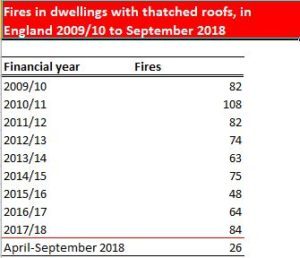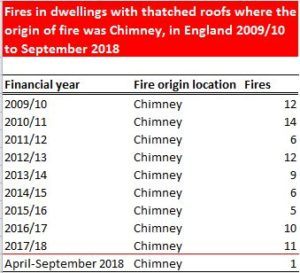Thatch Fire Statistics
You may have noticed our passion for thatch includes striving to reduce the number of thatch fires. Namely, promoting the up-to-date information on causes, risks and how to reduce them. Thatch fire statistics are therefore interesting.
The purpose of this article is to make you think about what thatch fire statistics you are presented with and how you interpret them appropriately so that you can make the best fire safety decisions.
We have updated this information to include some actual thatched roof fire statistics (for 2018) which are of real interest as well as some useful things to think about. – see below.
Fire Statistics from the Home Office
Below we have received a copy of the thatch fire statistics from the Home Office (April – March each year) along with the last and most up to date statistics (6 months from April to September 2018). We will obviously be very interested in the following 6 months data when it becomes available, which will cover this last winter period.
The information shows
- the Fires in dwellings with thatched roofs in England from 2008 to 2018
- the fires in dwellings with thatched roofs where the origin of the fire was Chimney.
Interpreting Thatch Fire Statistics
Initially when looking at statistics remember they can work in a variety of ways depending on how they are interpreted. We feel that the fire statistics are very useful in showing overall trends but that care should be taken when interpreting them for more in depth reasons than they were originally intended.
We are sure you have all heard of the term “lies, lies and damn statistics”. Sadly, as with many things in life, peoples understanding of the same information can vary in its interpretation. Statistics can often be cleverly manipulated to show something which was not an original intention. Care when looking at statistics and asking yourself about that information before making a decision is often a good idea.
Fire Statistics Raising More Questions
Firstly, the title says “fires in dwellings with thatched roofs”. It does not say thatched roof fires!
Understanding and interpretation of the data is essential to stop people making the wrong conclusions. This data above can include fires in tumble driers, electrical faults, candles, chip pans or all manner of causes which has not even affected the thatched roof. If we are looking for information on thatched roof fires we don’t think these statistics are what we are want.
We can look at the above tables and realise that there are a similar number of fires in the last reported year to the numbers almost 10 years ago. Time to ask more questions which, probably, this set of statistics can’t answer.
- Do the statistics answer the original questions?
- Who collected the information for the statistics
- When origin of thatch fire is noted was it from the Fire Service’s perspective, forensic investigator or other entity.
- Why was there a drop to 48?
Therefore, is that data collected and if so by whom? It has since been suggested that the drop was due to wetter weather conditions.
Secondly, the origin of the fire was chimney. What could this mean?
In this instance was it a chimney fire, breach in the chimney, ejected ember, burning birds nest or another chimney related origin….did a firework land next the chimney? There is room for more detail/understanding and potential for confusion or misunderstanding with this information as well.
Other Options for Thatch Fire Statistics
Firstly, insurers (forensic investigators) are obviously another group who may be able to give us more detailed and possibly more useful thatch fire statistics i.e. on fires in thatched roofs and the causes.
Secondly, there are those, like ourselves, who collect as much data as they can because they are interested in understanding what is going on! Please continue to keep letting us know of these incidents in case we miss any; social media, email or phone is fine and thank you. We try to find out causes but limited time and resources mean that all help is appreciated. Historic England, like us have been very interested in fires in Historic Buildings and all thatched properties and their input on statistics for this article is very appreciated.
Then there are reports stating that there are more thatched roof fires now than previously and that this coincides with a greater use of woodburners. This is probably true but where have these statistics come from? Perhaps it is not the woodburners that are the main risk but those who operate them, again interpretation of statistics.
Finally, some use statistics to say that listed properties are more at risk but we, and many of our associates, think that this just a case of probability as the majority of thatched cottages are listed. Low or damaged chimneys in such buildings are risk factor but the risk is not because they are listed or older properties.
The Thatch Advice Centre and Thatch Fire Statistics
The Thatch Advice Centre try to keep a list of thatched roof fires for our own information and understanding. We would probably not try to analyse this data as we are not specialists in that field nor do we have the resources to do it properly.. yet.
At a recent meeting with Historic England we have been given some true statistics of thatched roof fires. There were 31 Fires in thatched roofs in 2018 (all thatched properties, not just listed). To date this year as at time of writing to 15th March 2019 there have been 10 thatched roof fires. Are these not more useful than the Home Office ones which are more easily misinterpreted?
The need for proper recording of such information cannot be underestimated. It is so important as the lack of valuable data eg not including heritage fires or those of special interest eg thatched roofs means that analysing any information effectively in order to make improvements in fire safety is hampered.
Real statistics can be used to make a difference.
The Forensic Investigation Report information is well researched and many relevant questions asked are answered. This and the following Fire Protection Association research was very comprehensive.
There will always be more questions on thatch fires but we believe excellent progress is being made based on solid evidence from professionals. It is just important to think carefully about any statistics which are presented.
We hope this has made you think about thatch fire statistics. Remember, before making any decision or opinion based on statistics, we recommend you:-
- Understand the data
- Understand where the data came from
- Ask yourself those unanswered questions
- Think about what the data appears to say and how it could be otherwise interpreted
- Understand more than just the numbers
Fire Statistics and Insurance
Initially, let us hope that insurers don’t knee jerk react on the woodburner information. Understanding such statistics and associated research is showing that user interaction plays a huge part in safety and must not be underestimated. Based on the questions specialist insurers are now asking it is hopeful that they are on the right track.
Please also remember that insurers asking you to sweep your chimney or put up a bird guard is a good use of the current information from thatch fire statistics and research. It is helping to improve fire safety by reducing risks and, ultimately, stop premiums going through the roof!
What to do with Thatch Fire Statistics
Based on all the statistics available, we know the importance of understanding:
- the main proven cause of fire in thatch being ejected embers and chimney fires
- there are other causes of thatch fires and their risks should also be reduced
Please
- Read our updated Thatch Fire Safety Leaflet
- Read the Burgoynes Forensic Investigation Report into Causes of Thatch Fires
If you have a woodburner or open fire or thinking of one
- Read the Fire Protection Association Report
- Read the FPA Guidance
- Follow the Burnright Campaign
- Get it installed to building regulations
- Look at the newer ECO woodburners
Let’s Reduce the Thatch Fire Statistics
In looking at and learning from good proven information and research, understanding any relevant statistics and promoting the important advice from this data, we can work to reduce the number of thatched roof fires.
The statistics at the top of this blog are not all actual thatched roof fires so can be ambiguous if not read with understanding, so please be aware. Lets work to get the right information recorded so we can look at the real thatched roof fire statistics. Let us not be worried by statistics on thatched roof fires but use them as a tool to help improve fire safety.
We think it is important for everyone to work together to understand any fire statistics we are presented with and make a sensible decision on their benefits and how we have interpreted them. Read the more detailed information we have on this subject and make good choices on how you live and stay safe in your thatched home.




